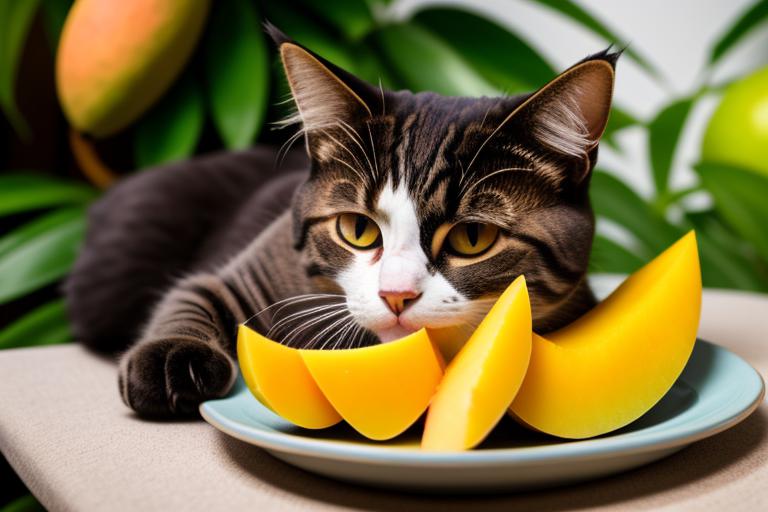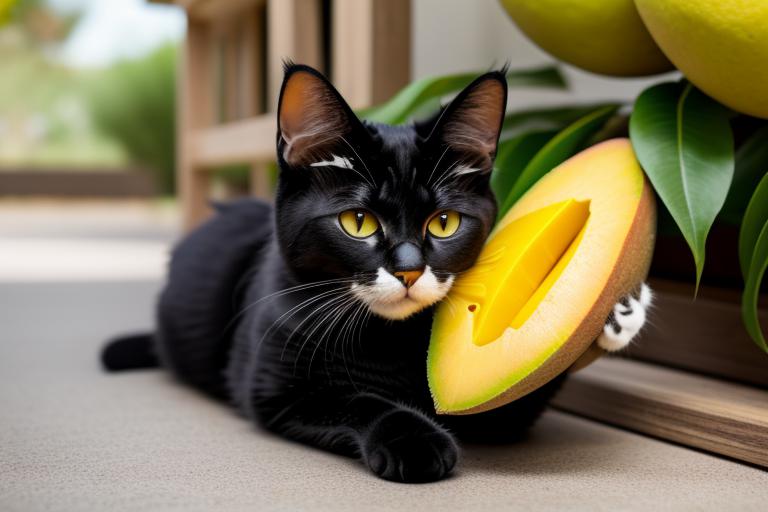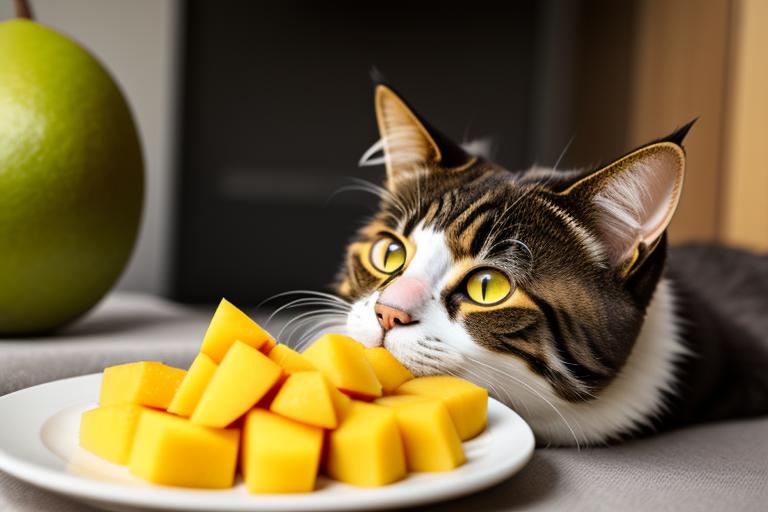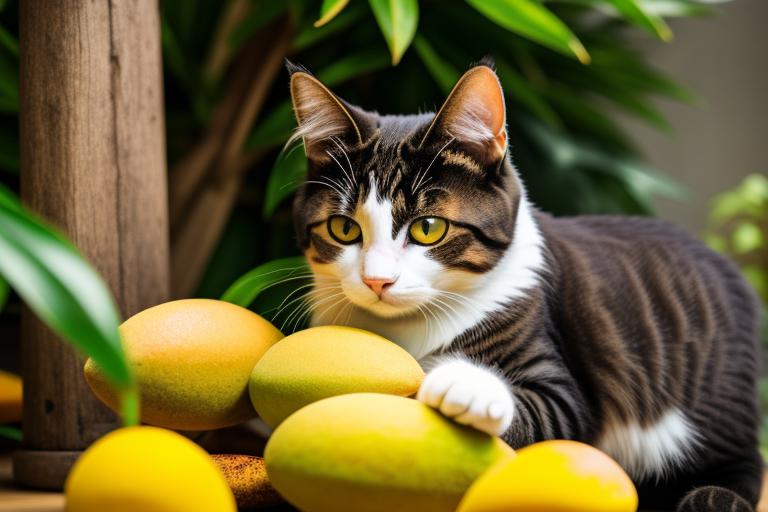As you ponder the culinary possibilities for your feline companion, you may find yourself wondering, can cats indulge in the tropical delight of mango? It’s a juicy question, one that may leave you craving answers.
Well, fear not, for we are here to shed light on this fruity dilemma. So, sit back, keep those whiskers perked, and let’s explore the world of cats and mangoes together.
Nutritional Benefits of Mango for Cats

Cats can benefit from the nutritional value of mangoes. While cats are obligate carnivores and primarily require a meat-based diet, incorporating small amounts of mango into their diet can provide them with some important nutrients. Mangoes are rich in vitamins A, C, and E, which are essential for maintaining a cat’s overall health. These vitamins support their immune system, promote healthy skin and coat, and help with proper eye function. Additionally, mangoes contain dietary fiber, which aids in digestion and can prevent constipation in cats.
However, it’s crucial to note that mangoes should only be given to cats in moderation. Too much mango can lead to an upset stomach or diarrhea due to their high sugar content. It’s recommended to offer small, bite-sized pieces of ripe mango as an occasional treat, rather than a regular part of their diet.
As always, consult with your veterinarian before introducing any new foods into your cat’s diet to ensure their safety and well-being.
Precautions to Take Before Feeding Mango to Your Cat

Before you offer your cat a taste of mango, there are a few precautions you should keep in mind.
Firstly, some cats may have allergies or sensitivities to mango, so it’s important to monitor their reaction closely.
Secondly, mango can be hard for cats to digest, potentially leading to stomach upset or diarrhea.
Lastly, remember that moderation is key – while a small amount of mango can be a tasty treat for your cat, too much can disrupt their diet.
Allergies and Sensitivities
To ensure the safety of your feline friend, it’s important to consider potential allergies and sensitivities before introducing mango into their diet. While mango is generally safe for cats to eat, some cats may have allergies or sensitivities to certain fruits, including mangoes.
Signs of an allergic reaction can include itching, swelling, vomiting, or diarrhea. If you notice any of these symptoms after your cat consumes mango, it’s best to consult with your veterinarian.
Additionally, it’s important to remember that mangoes should only be fed to cats in small quantities as an occasional treat. Too much mango can lead to digestive upset or an upset stomach. Always monitor your cat’s reaction to new foods and consult a professional if you have any concerns.
Potential Digestive Issues
If your feline friend experiences any digestive issues after consuming mango, taking precautions before feeding it to them is essential.
Mango contains natural sugars and fibers that can be challenging for cats to digest. Before offering mango as a treat, make sure to remove the skin, pit, and any other potential choking hazards.
Additionally, it’s crucial to introduce mango gradually into your cat’s diet. Start with small portions and monitor their response closely. Keep an eye out for any signs of gastrointestinal distress, such as vomiting or diarrhea.
If your cat shows any adverse reactions, it’s best to avoid feeding them mango altogether. Always consult with your veterinarian before introducing any new food into your cat’s diet to ensure their digestive health and overall well-being.
Moderation Is Key
When feeding mango to your cat, it’s important to take precautions and ensure moderation. Here are some things to keep in mind:
- Remove the pit and skin: Before offering mango to your cat, make sure to remove the pit and skin. These parts can be a choking hazard and may cause digestive issues.
- Introduce it gradually: Start by giving your cat a small amount of mango as a treat. Observe their reaction and monitor for any signs of allergies or stomach upset. If your cat shows any adverse effects, discontinue feeding mango.
- Monitor portion sizes: Mango should only be a small part of your cat’s diet. Too much mango can lead to an upset stomach or diarrhea. Stick to giving small, occasional pieces of mango as a special treat.
- Consult with your vet: If you have any concerns or questions about feeding mango to your cat, it’s always best to consult with your veterinarian. They can provide personalized advice based on your cat’s specific needs and health condition.
How to Prepare Mango for Your Feline Friend

To prepare mango for your feline friend, start by cutting a small portion of ripe mango into bite-sized pieces. Make sure to remove the skin before serving it to your cat, as the skin can be difficult for them to digest.
Safe Mango Portions
You can safely prepare mango for your feline friend to enjoy. Here are four steps to follow when preparing mango for your cat:
- Remove the skin: Cats may have difficulty digesting the tough skin of a mango, so it’s best to peel it off before serving. Make sure to remove all the skin, as it can be a choking hazard.
- Remove the pit: The mango pit isn’t safe for cats to consume, as it can cause choking or intestinal blockage. Be sure to cut around the pit and discard it before giving the mango to your furry friend.
- Cut into small, bite-sized pieces: Cats have small mouths, so it’s important to cut the mango into small, manageable pieces. This will make it easier for them to eat and reduce the risk of choking.
- Offer in moderation: While mango can be a delicious and nutritious treat for cats, it should be given in moderation. Too much mango can cause digestive upset or diarrhea. Offer small portions as an occasional treat.
Removing Mango Skin
Remove the tough skin of the mango to ensure it’s safe and easily digestible for your feline friend. Cats may struggle to chew and swallow the skin, which can pose a choking hazard or cause digestive issues.
To remove the skin, start by cutting off the top and bottom of the mango. Then, use a knife to carefully slice off the skin from top to bottom, following the natural curve of the fruit. Be sure to remove all the skin, as even small pieces can be difficult for your cat to handle.
Once the skin is removed, you can cut the mango into small, bite-sized pieces for your furry friend to enjoy. Remember to always supervise your cat while they’re eating mango to prevent any accidents or discomfort.
Recommended Portion Sizes for Cats Eating Mango
Cats should be given mango in moderation, considering their smaller size and dietary needs. While mango can be a healthy addition to a cat’s diet, it shouldn’t make up a significant portion of their meals. Here are some recommended portion sizes for cats eating mango:
- Start with small amounts: Begin by offering your cat a small, bite-sized piece of mango. Observe their reaction and monitor for any signs of digestive upset or allergies. If they tolerate it well, you can gradually increase the portion size.
- Limit the amount: Cats have different nutritional requirements than humans, so it’s important not to overfeed them with mango. A good rule of thumb is to offer no more than one or two small pieces of mango as a treat, a few times a week.
- Watch for changes in behavior or stool: Keep an eye on your cat’s behavior and stool consistency after eating mango. If you notice any negative changes, such as vomiting or diarrhea, reduce or eliminate mango from their diet.
- Consult with your veterinarian: If you have any concerns or questions about feeding mango to your cat, it’s always best to consult with your veterinarian. They can provide personalized advice based on your cat’s specific needs and dietary restrictions.
Signs of Allergic Reactions in Cats to Mango
If your cat has an allergic reaction to mango, there are certain signs you should watch out for. Allergic reactions occur when your cat’s immune system overreacts to a specific substance, in this case, mango.
The signs of an allergic reaction can vary from mild to severe and may include gastrointestinal upset, such as vomiting or diarrhea. Your cat may also exhibit skin-related symptoms like itching, redness, or a rash. In some cases, your cat may develop respiratory symptoms such as sneezing, coughing, or difficulty breathing. Swelling of the face, lips, or tongue can also occur, which is a serious symptom that requires immediate medical attention.
If you notice any of these signs after your cat has consumed mango, it’s important to contact your veterinarian right away. They’ll be able to determine if it’s indeed an allergic reaction and provide the necessary treatment. Remember, it’s always best to introduce new foods to your cat gradually and in small amounts to monitor for any adverse reactions.
Other Fruits Safe for Cats to Eat
After considering the signs of allergic reactions in cats to mango, it’s important to explore other fruits that are safe for cats to eat. While mango may not be the best option for your feline friend, there are several other fruits that can be a healthy addition to their diet.
Here are four safe fruits that cats can enjoy:
- Apples: Apples are a great source of fiber and can help improve digestion in cats. Make sure to remove the seeds and core before giving it to your cat.
- Blueberries: These small berries are packed with antioxidants and are safe for cats to eat. They can be given as a treat or added to their meals.
- Watermelon: This refreshing fruit is a great source of hydration for cats. Remove the seeds and rind, and offer small pieces to your cat as a special treat.
- Bananas: Bananas are a good source of potassium and can be beneficial for cats. Mash a small piece and mix it with their regular food as a tasty addition.
Frequently Asked Questions
Cats should not eat the skin of a mango. While the flesh is safe in moderation, the skin can be difficult to digest and may cause gastrointestinal issues. Stick to feeding your cat approved cat food.
Feeding mango to cats can pose potential risks. While some cats may enjoy the taste, they may have difficulty digesting it. Additionally, the high sugar content could lead to weight gain or diabetes.
Yes, cats can eat mangoes that are not fully ripe. However, make sure to remove the skin and pit, as they can be difficult to digest. Moderation is key to avoid potential digestive issues.
Cats can eat canned or processed mango, but it is not recommended. The added sugars and preservatives might upset their stomachs. It’s best to stick to fresh, ripe mangoes as an occasional treat.
Specific breeds of cats should not eat mango as it can cause digestive issues. It’s best to consult with a veterinarian to determine if your cat’s breed is at risk.
Conclusion
In conclusion, mango can be a safe and nutritious treat for cats when given in moderation. It’s important to properly prepare and serve the mango to ensure it’s safe for your feline friend.
However, it’s crucial to be aware of any potential allergic reactions and to always consult with a veterinarian before introducing any new foods to your cat’s diet.
Remember, there are also other fruits that are safe for cats to enjoy as well.

